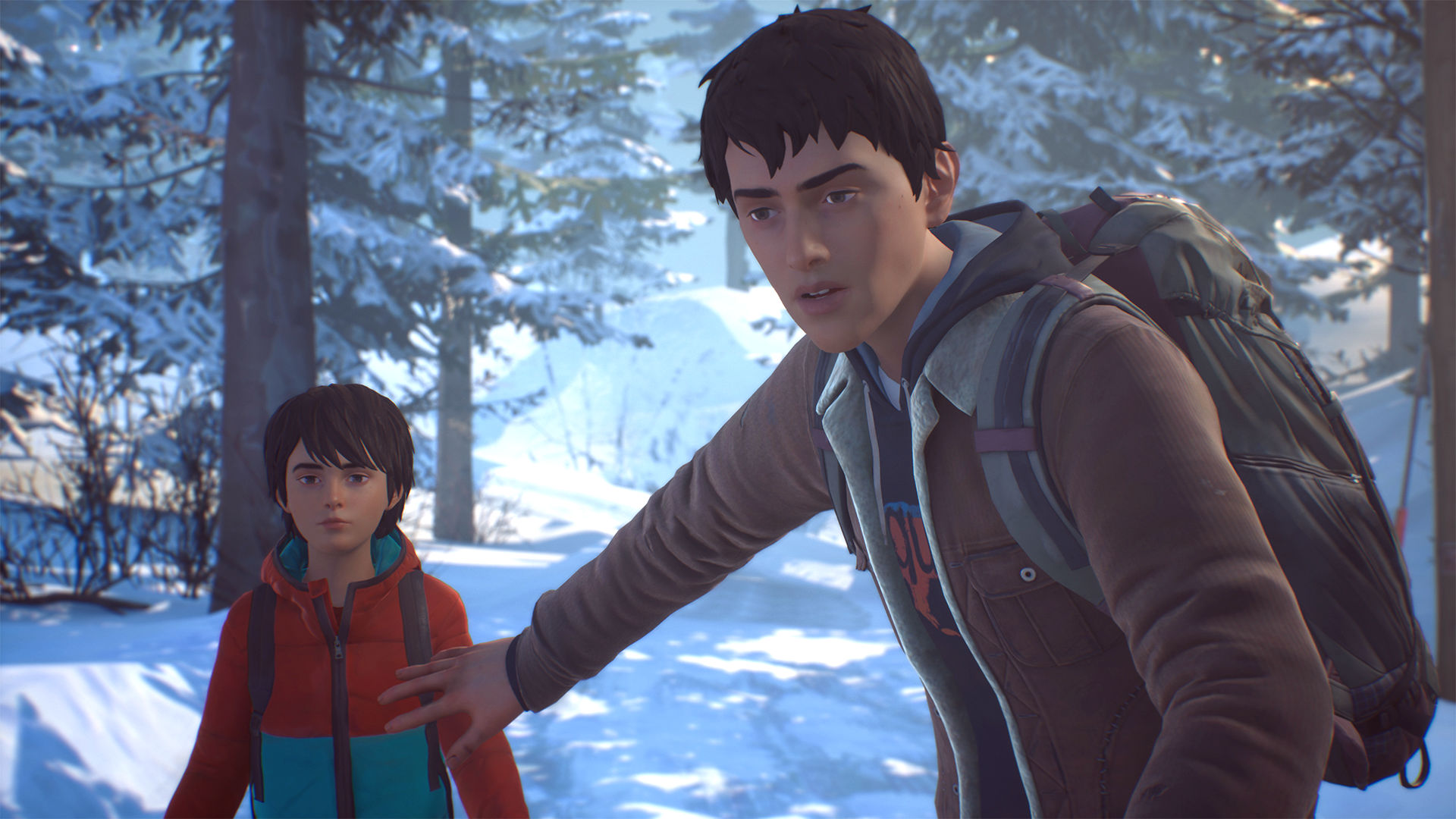videogame reviews



★★★★★★★☆☆☆

Now we’re talking.
After the tedious indulgence of Life is Strange and the dreadful continuity of Before The Storm, I had many reasons to be skeptical of, if not downright repelled by, Life is Strange 2. And I was, believe me. You couldn’t squeeze more patience out of me to entertain yet another bastardization of The Walking Dead’s first season; yet another futile, cowardly tale about fake teens. And, well, I have no idea why I gave this one a try, but I did. And oh boy, it was one hell of a ride.
Life Is Strange 2 follows the journey of two siblings, Sean and Daniel, who escape their home after the murder of their father at the hands of a police officer unveils Daniel’s supernatural powers. It is our duty as Sean, the big brother, to take care of Daniel and help him manage his new abilities.
The premise here resembles that of The Walking Dead in many aspects. The inexperienced caretaker as a protagonist, the balance between doing what’s right and doing what’s safe, the idyllic house that becomes dangerous, their separation, the conflictive objectives of each other. I could go on, but you get the idea. There are, however, two big differences: Daniel is not as docile as Clementine is, and this tale is more hopeful than Lee’s.
Life is Strange 2’s story, just as its protagonists, proceeds in a rash, urgent manner. With little time to linger on liminal periods, to grow organically. We don’t follow Daniel as he becomes stronger, or Sean as he falls for his crush; those things are shown to us once they’ve already happened. We’re there to see them explode, but see them explode without giving up an ounce of hope.
The Walking Dead often painted trust, solidarity or sincerity—traits that define humanity—as naïve, or used cynical sensationalism to stress that you can’t help everyone. Life is Strange 2 portrays the worst of this world—often channeled through racism and police violence—but doesn’t let it sink in spiritually. You’re never punished for trusting those who want to help you. None of them end up tying you up in a dark room—and the ones who do, you see them coming from a mile away. Call me idealistic, but I appreciate this narrative. In the face of adversity, I believe people come together and not the other way around. Imagine a tale about brotherhood and injustice that encouraged isolation and extreme wariness. There’s no truth or power to a tale like that.
This story has been overwhelming to me unlike any other I remember. You can thank my little brother, with whom I share an age difference and relationship very similar to Sean and Daniel’s. This conditioned my experience, of course, but let’s give credit where credit is due because the game does pull its own weight and a lot more in this regard. The way their brotherhood is written is just delightful. By far, the most inspiring part of the adventure and a single-handed reason for me to cherish the whole work.
It also made me realize something: the best choices aren’t the ones that emphasize the act of making a choice, the prospect of its consequences, or the impact it will have in the game world. The best choices are those you don’t realize you’re making. When I chose to hang out with Cassidy and Finn instead of going to sleep with Daniel, I didn’t give it much importance until I found out about Daniel’s loneliness. And to be honest, I would make that mistake again, because Sean is young, and he wants to socialize and have fun as any teenager should be able to.
And let’s not forget about the ending. In Life is Strange, the last choice was not a real choice. It served nothing. It was crude and trivial, even though its consequences were huge. Then there’s The Walking Dead, with another fake choice. This time for good. You didn’t have to decide over anything since the conclusion was the same no matter what you chose. The single choice there was to accept the situation as is. To move on.
This time, the choice was both real and resounding. The relationship between the brothers crystallizes here as a promise for the future, now that the journey is over. Neither of the outcomes feels quite right or wrong, although one is more unfair than the other. That’s the one I chose. And I did because, for me, there wasn’t a choice. It wasn’t worth it, but it was the natural course of action, considering how I had been playing the game and my personal baggage. I’ve never felt more disempowered in a videogame about choice. Refreshing? Well, for sure. But I’m still not satisfied.
Turns out there are two more endings. You get them by having a low morality score—ah shit, here we go again. Life is Strange 2 centers Daniel’s education. You’ve got to teach him how to tell right from wrong, be compassionate, responsible, etc. At certain points, his responsiveness to your commands depends on your previous behavior; your influence is huge and his temper is short, so you can imagine how tumultuous the dynamic between the two can get. However, was it necessary to reiterate it with an extra pair of endings? Nope. No, it wasn’t. It renders the theme of education utilitarian. The mere existence of these endings bugs me, but don’t even get me started on their content. Let’s just say they speculate about why juvenile crime exists with embarrassing conclusions. But alas, that’s far from the worst.
A lot of these videogames are so insecure about their alleged lack of gameplay that they introduce small doses of interactivity here and there. Sometimes in the shape of quick-time events, other times in the shape of sterile puzzles. Life is Strange 2 has both. I remember the first one appearing when you try to convince Daniel to come with you. You have to win this microgame multiple times for him to do so as if you “kept trying no matter what”. And look, that’s the problem with this videogame imposter syndrome: it always leads to puerile ludic metaphors.
If a situation appears gamifiable enough, they’ll go for it. Have to get in locked a room? Let’s hide a key in the house and let the player look for it just because. Your brother is in danger? I’m sure you want to play this stealth minigame before advancing the plot. And the peak of absurdity: morality puzzles. That’s right. You can escape from here using brute force, but that would be bad (and Daniel would remember). Instead, you can solve this real-time puzzle about moving furniture to harm zero cops and be a good brother.
I get that you do whatever it takes to produce a deep connection between the player’s situation and the avatar’s. I get how simulating physical and psychological states might seem like the way to go when it comes to empathetic design. Yet, this blatant assumption of distance, these loud maneuvers of seduction, and the game dynamics that emerge as a result prove how desperate Life is Strange 2 is to reach a specific target audience that has little in common with these two Latinx kids.
Though the game is sensible and well-informed for the most part, some choices are questionable in the purpose they serve. When Sean is pulled out of a car by two bigots, you get to choose between something that’s racist and humiliating but safe and something that’s combative and dignifying but dangerous. They intended this choice for white people. Anyone with a similar background and/or experience would choose to keep Sean safe, or at least, wouldn’t read this scene as a moral dilemma. Here the game says “What is worse, doing A Racism to this brown kid as a white player or putting him in harm’s way, again, as a white player?” If empathy is built upon the exclusion of the people whose voice you want to reproduce, then something’s not working as it should. Now, let me guess what that is.
Life is Strange 2’s simulationist approach to the unresolved narrative, aesthetic, and ideological spaces points to the unwillingness of this project to let go of the Life is Strange brand; to the risks the series isn’t going to take. I guess, for some, holding on to a sinking ship is worth it, even if your achievements get watered down as a result.
— calei2copi0
